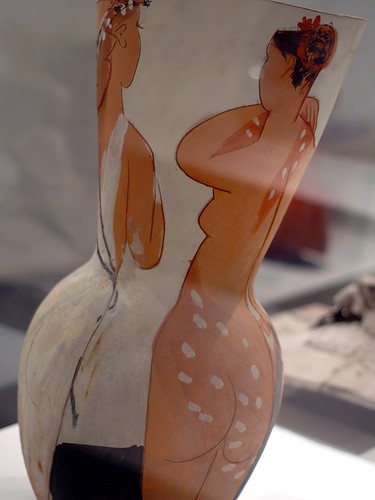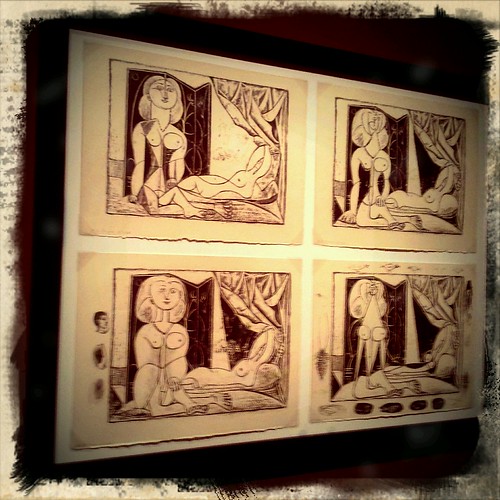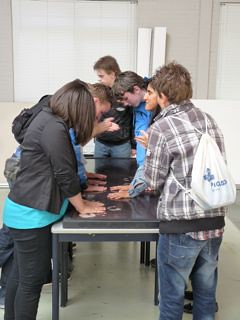Archive for the ‘pablo picasso’ Category:
What Makes a Person Intelligent?

In traditional intelligence theories when one is asked the question “What makes a person intelligent?” the most common responses will often note a person’s ability to solve problems, utilize logic, and think critically. These typical traits of intelligence are sometimes grouped together under the heading “raw intelligence”. A person’s intelligence, traditionally speaking, is contained in their intellect. In other words, how we each understand, evaluate or respond to external stimuli, regardless as to whether it is a mathematical problem or anticipation of an opponent’s next move in a game, is our collective intelligence. Our intelligence therefore, is our individual, collective ability to act or react in a continually changing environment.
The principal problem in traditional intelligence theories is that they promote “fractured learning”. Many educational reformers have clearly stated that “taking tests merely shows that a student is skilled at taking tests”. At best, traditional tests focus on only about one tenth of an individual’s intellect. Note that Albert Einstein and Thomas Edison, two of history’s most famous examples of brilliant minds, were terrible at taking traditional tests, therefore terrible at “school” in general. Multiple Intelligences theory then, demonstrates that the ability to take traditional tests is almost entirely in the realm of the Logical – Mathematical
intelligence. This intelligence will be detailed later along with the Interpersonal intelligence, which imparts in some students the ability to second guess a teacher’s structuring of a test. Traditional IQ tests predict school performance with considerable accuracy, but they are only an indifferent predictor of performance in a profession after formal schooling.
In an interesting but controversial study conducted during the 1960’s by Biologist Marion Diamond, of the University of California at Berkeley, two sets of rats were raised in different environments; One set had toys to play with, playmates to romp with and a roomy box that was kept clean and fresh. The second set was put in solitary confinement; all alone in a much smaller cage with no toys to enjoy. After several weeks, Diamond measured the size of each rat’s cerebral cortex, the brain area which is responsible for higher nerve functions. The rats in the sociable, clean and stimulating environment grew brains bigger than the rats with the impoverished surroundings. “Does the enriched environment increase the dimensions of the brain, and does the impoverished environment decrease the dimensions of the brain?”, asked Diamond. “The answer, very clearly, is YES.” Similar results were replicated with cats, monkeys and later with humans. So a stimulating, enriched learning environment is crucial to mental development. If we likewise incorporate the varying student intelligences in our teaching activities, our success as well as our students success, will be markedly improved. That each of us possess all the intelligences, that they can each be developed further, that these multiple intelligences work together in a complex manner, and that there are, in fact, many different ways to be “intelligent” are inclusive in a study by Armstrong. Here briefly, in retrospect, are eight of the major intelligences of Howard Gardener’s theory and their relative traits:
Verbal-Linguistic Intelligence:
The capacity to use words effectively, either orally or in writing. It is highly developed in story-tellers, orators, politicians, poets, playwrights, editors, language teachers and journalists. Students with a high degree of this intelligence think in words; learn by listening, reading, and verbalizing. They enjoy writing, like books, records, and tapes, and have a good memory for verse, lyrics, or trivia. Getting into discussions, telling jokes and debating are also characteristics of this intelligence. Maya Angelou is strong in this intelligence.
Visual-Spatial Intelligence:
The ability to perceive the world accurately and to perform transformations upon one’s perceptions. This is highly developed in guides, interior designers, architects, artists, fashion designers and inventors. Students with a high degree of spatial intelligence think in images and pictures, like mazes and jigsaw puzzles. They like to draw and design things, and enjoy films, slides, videos, diagrams, maps, charts. The daydreamers and those who may have strong opinions about such things as colors that go together, textures that are appropriate and pleasing and decorating are included in this intelligence. Pablo Picasso was strong in this intelligence.
Musical – Rhythmic Intelligence: The capacity to perceive, discriminate, transform, and express musical forms is most highly developed in musical performers, music aficionados, and music critics. Students with a high degree of musical intelligence learn through rhythm and melody, play a musical instrument, or May need music to study. They notice nonverbal sounds in the environment: the chirp of a cricket, rain on the roof, varying traffic patterns, and usually learn things more easily if sung, tapped out, or whistled. These people love music and rhythmic patterns and can often reproduce a melody or rhythmic pattern after hearing it only once. Various sounds, tones, and rhythms may have a visible effect on them (that is, you can see a change in facial expressions, body movement, or emotional responses). They enjoy singing and listening to a wide variety of music, and are often quite skilled at mimicking sounds, language accents, and others’ speech patterns, and recognizing different musical instruments in a composition. Paul McCartney is strong in this intelligence.
Logical-Mathematical Intelligence:
The capacity to use numbers effectively and to reason well. This intelligence is highly developed in mathematicians, tax accountants, statisticians, scientists, computer programmers, and logicians. Students with a high degree of this intelligence often reason things out logically and clearly; look for abstract patterns and relationships; frequently like brain teasers, logical puzzles, and strategy games. They also like to use computers and to classify and categorize. These people think conceptually and abstractly and are able to see patterns and relationships that others often miss. They like to experiment, solve puzzles and other problems, ask cosmic questions and think. They love the challenge of complex problems to solve and always have a logical rationale or argument for what they are doing or thinking. Albert Einstein was strong in this intelligence.
Bodily-Kinesthetic Intelligence: Consists of expertise in using one’s whole body to express ideas and feelings, and facility in using ones hands to produce or transform things. A highly developed intelligence in actors, mimes, athletes, dancers, sculptors, mechanics, and surgeons. Students with a high degree of bodily-kinesthetic intelligence process knowledge through bodily sensations; move, twitch, tap, or fidget while sitting in a chair or at a desk and learn by touching, manipulating, and moving. They typically like role playing and creative movement and generally like physical games of all kinds and demonstrating how to do something. They communicate well through body language and other physical gestures. They can often perform a task only after seeing someone else do it. They find it difficult to sit still for a long time and are easily bored if they are not actively involved in what is going on around them. Michael Jordan is strong in this intelligence.
Interpersonal Intelligence:
The ability to perceive and make distinctions in the moods, intentions, motivations, and feelings of other people. This Intelligence can include sensitivity to facial expressions, voice, and gestures, as well as the ability to respond effectively to such cues. Students with a high degree of interpersonal intelligence understand and care about people; like to socialize; learn more easily by relating and cooperating and are good at teaching other students. These people learn through person-to-person interaction. They generally have lots of friends; show a great deal of empathy for other people and understanding of different points of view. They are skilled at drawing others out in a discussion, conflict resolution and mediation when people are in radical
opposition to each other. Mother Teresa and Mahatma Gandhi were strong in this intelligence.
Intra-personal Intelligence:
Self-knowledge and the ability to act adaptively on the basis of that knowledge define this group. This is an intelligence which can include having an accurate picture of one’s strengths and limitations, awareness of one’s moods and motivations, and the capacity for self-discipline. Students with a high degree of this intelligence seem to be self-motivating; need their own quiet space; may march to the beat of a different drummer and tend to learn more easily with independent study, self-paced instruction, individualized projects and games.
These people like to work alone and sometimes shy away from others. They are self-reflective and self-aware and thus tend to be in tune with their inner feelings, values, beliefs, and thinking processes. They are frequently bearers of creative wisdom and insight, are highly intuitive, and are inwardly motivated rather than needing external rewards to keep them going. They are often strong-willed, self-confident, and definite, well-thought-out opinions on almost any issue (although they are sometimes off-the-wall). Other people will often come to them for advice and counsel, but others will sometimes view them as distant or weird. Emily Dickinson and Stephen King are examples of this intelligence.
Naturalist Intelligence:
Environmental knowledge and the ability to identify and categorize plants, animals and nature on the basis of that knowledge. The Naturalist Intelligence can include having an accurate picture of the ambient environment, awareness of the interrelationship of natural elements, and the capacity for self-analysis of these elements. It is found most highly developed in archeologists, animal handlers, animal trainers, veterinarians, biologists, racehorse jockeys, zoologists, environmentalists, wilderness guides and naturalists. Students who have a high degree of the naturalist intelligence seem to be nature-oriented, seek to be outdoors or in the elements and learn more easily with nature-related study and environmental projects and activities. They like to collect items from nature, study them, and group them. They tend to be aware of subtleties in appearance, texture, and sounds that those weaker in this intelligence may not grasp. Charles Darwin, Jacques Cousteau, and John James Audubon were strong in this intelligence.
One of the great promises of Multiple Intelligences theory in education is that it will help us to find individual pathways into and out of our students’ minds. Recent advances in educational psychology and research in applied MI theory offer educators a real possibility of developing the potential of all students. Both educators and students should derive from Gardner’s Multiple Intelligence theory that all people are different and learn differently, and that we should respect, value, and nurture that diversity.
Reference Websites:
Reference website for multiple intelligences links and activities:
[http://surfaquarium.com/im.htm]
Exploring Multiple Intelligences: New Dimensions of Learning
[http://www.multi-intell.com/]
Multiple Intelligences Resources
http://www.theatreinmotion.com/resources.htm
Basic MI Theory
http://edweb.gsn.org/edref.mi.th.html
Multiple Intelligence Theory: Principles
http://www.harding.edu/~cbr/midemo/prin.html
Multiple Intelligences: Theory and Practice in the K-12 Class
[http://www.indiana.edu/~eric_rec/ieo/bibs/multiple.html]
Task Card Overview/Multiple Intelligences
[http://www.metronet.com/~bhorizon/teach.htm]
Association for the Promotion and Advancement of Science Education activities website – http://discoverlearning.com/forensic/docs/index.html
Naturalist Intelligence – Sea World / Busch Gardens website for students
http://www.seaworld.org/animal_bytes/animal_bytes.html
Visit : Painting Instructional Thai-English English-Thai Dictionary IPhone G3 aframeshop senior equipment
"I Carry Your Heart With Me," A Discussion of the Poem by E. E. Cummings

The poem, “i carry your heart with me,” by E. E. Cummings has been a favorite love poem and a favorite selection at weddings for many years. The poem has gained renewed interest since being featured in the film, “In Her Shoes.” It is used with devastating effect in the film’s climactic wedding scene and again to close the movie. Countless fans have been inspired to review the touching words of “i carry your heart with me.”
The Poet
E. E. Cummings was born Edward Estlin Cummings in 1894 in Cambridge, Massachusetts. He died in North Conway, N.H., in 1962. Cummings earned a B.A. degree from Harvard in 1915 and delivered the Commencement Address that year, titled “The New Art.” A year later he earned an M.A. degree for English and Classical Studies, also from Harvard.
Cummings joined an ambulance corps with the American Red Cross in France during World War I. The French imprisoned him on suspicion of disloyalty, a false accusation that put Cummings in prison for three months. He wrote the novel, The Enormous Room, about his experience. Many of Cummings’ writings have an anti-war message.
Cummings was a fine artist, playwright and novelist. He studied art in Paris following World War I and he adopted a cubist style in his artwork. He considered himself as much a painter as a poet, spending much of the day painting and much of the night writing. Cummings particularly admired the artwork of Pablo Picasso. Cummings’ understanding of presentation can be seen in his use of typography to “paint a picture” with words in some of his poems.
During his lifetime Cummings wrote over 900 poems, two novels, four plays, and had at least a half dozen showings of his artwork.
Contrary to popular opinion Cummings never legalized his name as, “e.e. cummings.” His name properly should be capitalized.
The Poem
E. E. Cummings’ poetry style is unique and highly visual. His typographical independence was an experiment in punctuation, spelling and rule-breaking. His style forces a certain rhythm into the poem when read aloud. His language is simple and his poems become fun and playful.
Cummings’ poem, “i carry your heart with me,” is about deep, profound love, the kind that can keep the stars apart and that can transcend the soul or the mind. The poem is easily read, easily spoken, and easily understood by people of all ages.
The poem could almost be called a sonnet. It has nearly the right number of lines in nearly the right combination. But, typical of a Cummings poem, it goes its own direction and does so with great effect.
The poem makes an excellent love song when set to music. The outstanding guitarist, Michael Hedges, has set “i carry your heart” to music on his “Taproot” album. Hedges himself sings the lead, but the backing vocals are sung by David Crosby and Graham Nash.
More than 168 of Cummings’ original poems have been set to music.
Enjoy the words and the sentiments of this famous poem.
i carry your heart with me
i carry your heart with me (i carry it in
my heart) i am never without it (anywhere
i go you go, my dear; and whatever is done
by only me is your doing, my darling)
i fear
no fate (for you are my fate, my sweet) i want
no world (for beautiful you are my world, my true)
and it’s you are whatever a moon has always meant
and whatever a sun will always sing is you
here is the deepest secret nobody knows
(here is the root of the root and the bud of the bud
and the sky of the sky of a tree called life; which grows
higher than soul can hope or mind can hide)
and this is the wonder that’s keeping the stars apart
i carry your heart (i carry it in my heart)
Related : Thai-English English-Thai Dictionary Scubaequipment Kindle Store eBook welcomeholidayservice.com
7 Interesting Facts About Pablo Picasso

1. Pablo Picasso‘s Full Name is Extremely Long
Pablo Diego Jose Francisco de Paula Juan Nepomuseno Maria de los remedies Ciprano de la Santasima Trinidad Martyr Patricio Clito Ruiz y Picasso! That was quite a mouthful! Pablo Picasso‘s name is one of the longest ever recorded for an artist or any person for that matter. His name is a combination of respect for Spanish and Christian sainthood and family heritage. There are a few names of important saints and beloved relatives, his mother and father’s names, and the rest are a combination of ideas and personal characteristics, in which the Spanish believed are best included in a birth name. Inevitably, a rose by any other name is still a rose, and Pablo Picasso and his long name illustrated that saying, in the grandest of fashions.
2. Baby Pablo Almost Stillborn
When baby Pablo was born, the midwife actually thought that he was stillborn and left the newborn genius on a pediatrician table and was not given another thought! The midwife went to Pablo‘s mother to inform her of the sad news, and a miracle occurred during this time. Pablo‘s uncle was also the attending physician who delivered the baby! Dr. Don Salvador is credited with saving the life of newborn Pablo.
3. Little Picasso‘s First Spoken Word ‘Pencil’
Picasso‘s early childhood developmental years were filled with education and wonder! His very first spoken-word was ‘piz’ or ‘pencil’, in English. If this was not a clue to the future-occupation and career-path of young Picasso, then nothing short of having a label on his back that said ‘artist-to-be’ would have been any clearer!
4. Pablo‘s Very First Oil Based Drawing
‘Le Picador’, was created in 1890, by Pablo Picasso, at the tender age of nine. The first work by Picasso depicted a man riding a horse in the blood-sport that is bull fighting. This form of spectator-event is still widely-popular in many parts of Spain.
5. Pablo Picasso‘s ‘First Communion’ First Academic Painting
Although Pablo‘s first foray into artistic endeavors was ‘Le Picador’ at nine in 1890, his very first academic all painting was not painted until six years later. The work, ‘First Communion’, is a portrait of his mother, father, and youngest sister, all kneeling before an altar in a church setting. Pablo Picasso was only 15 when he created this masterpiece, and this work is considered one of his most-treasured of all!
6. Pablo Picasso and His Academic Career
There is little argument that Pablo Picasso was a brilliant man, yet his academic career record does not reflect this fact. Pablo had little trouble passing the entrance exams of every artistic institution of higher learning, from Madrid to Paris, which he desired to gain entry into. It was the empirically-proven mark of a tortured artist, after time and time again of Pablo burning-out and leaving school after one or two semesters. This did not make any difference after he became successful after ‘First Communion’, yet was a clear sign that brilliant individuals sometimes have difficulty in a structured formal classroom setting.
7. Pablo Picasso‘s First Job in Paris
The first job that Pablo Picasso was to be paid upon was with his landlord/art dealer, Pere Menach. The agreed-upon sum was 150 francs per month, which in today’s money, equates to about $750 USD. Not a bad sum of money back in the day and one that allowed young Pablo to exercise his creativity and to develop his personal characteristics, that would carry him through the rest of his long life.
Recommend : Kindle Store eBook Thai Food Good Health Thai-English English-Thai Dictionary welcomeholidayservice //fengshui//
Famous People From Spain

Spain is one of those countries that played a huge role in shaping the world’s history. It is one of the most powerful nations during the middle Ages, owing largely to the number of explorations and discoveries that its people have made in the New World and beyond. But more than the cultural and religious influences that this country has spread to the world, it has given birth to notable personalities that are widely known in practically every part of the globe. Here are some of the most famous people in Spain from the past to the present.
Juan Sebastian Elcano
Elcano was an explorer and sailor who is known for being the first man to complete a circumnavigation of the world. He was part of Ferdinand Magellan’s expedition to the Philippines. However, after his group was defeated in the Battle of Mactan which also led to Magellan’s death, Elcano was forced to retreat, taking what remained of the fleet back to Spain. In the end, only the ship Victoria with only 17 survivors of the 240-man expedition along with 4 Timorese Asians managed to get to Spain, thereby completing a voyage around the world
Miguel de Cervantes
Miguel de Cervantes is another one of the most famous people from Spain. He is well known for creating the literary classic Don Quixote. This novel is considered the most influential literary masterpiece that emerged from the Golden Age of Spain and from its entire literary canon at that. It is one of the foundations of modern Western literature and is one of the greatest works of fiction ever published.
Pablo Picasso
Pablo Picasso is a celebrated painter and sculptor, widely recognized for his 20th century art masterpieces. He is known as one of the founders of the Cubist movement and for a number of styles under this genre that are embodied in this works. A lot of people recognize his works even from afar. Some of his more notable Cubist works include the Les Demoiselles d’Avignon and the Guernica. He became one of the most famous people from Spain as practically every art class in the world has covered at least one or two of his works. Most of today’s art genres are based on the styles that he has developed.
Famous people from Spain in the present times
But aside from the hundreds of notable Spanish people in world history, there are the contemporary Spaniards who have made their own mark in the modern times. Singers, artists, and other personalities of Spanish decent have become household names over the years. Who wouldn’t recognize the name Antonio Banderas who starred in a number of high-profile Hollywood films? His movies, Interview with the Vampire, the Mask of Zorro and even his character as the voice of Puss in Boots in the Shrek trilogies will forever be remembered by viewers all over the world.
Then there is Enrique Iglesias, singer and songwriter, who to this day holds the record for producing the most number of Spanish-language singles that made their way to the Billboard’s Hot Latin Tracks. When it comes to contemporary Latino music, Iglesias is probably one of the most famous people in Spain and the rest of the world.
See Also : Scubaequipment Painting Instructional IPhone G3 Brick Mailbox SugarDecor //fengshui//
6 Films About Painters

Cinema is an art form in itself. Regardless of the subject, all films are judged by its mastery of cinematography, the creativity and genius of the director and screenwriters, and the skill and believability of the actors.
One need not forget that they are in fact watching a film, a representation of some subject. It’s like staring into a moving painting, as entire experience of sight, sound and imagination. Andy Warhol used to purposely put little mistakes and blips into his screen shots to remind the viewers that they are not actually seeing a situation as you would looking out your window, but rather you are experiencing a movie of one.
The never ending quest for knowledge takes us through books, articles, lectures, blogs, and so forth to teach us about any particular subject. It can also give us movies on our subject and this, of course, is the most exciting way of learning. Movies about art and art history can be found all over and there are plenty of good ones. Here I have a short list of some of the movies about painters, most of which I’ve seen. And of course, you can’t get away without having to put up with some of my opinions on them.
1. Basquait ***
This movie is great and filled with an all-star cast including David Bowie (as Warhol), and Dennis Hopper (as dealer Bruno Bishofberger), with parts played by Benicio del Toro and Gary Oldman, and cameo appearances by Christopher Walken and Courtney Love. Jeffrey Wright plays the New York “graffiti”-style artist Jean Michel Basquiat, and although he doesn’t look exactly like him, portrays the artist pretty well. The film is directed by artist Julian Schnabel.
This really is a fun, upbeat movie that gracefully goes from scene to scene with non stop entertainment. It follows the years of the American painter when he seemed to explode onto the art scene with his abstract graffiti inspired art. It centers on him catching the interest of the pop-artist Andy Warhol. This odd couple instantly forms a bond. The older, more experienced and successful Warhol used Basquiat’s young, new energy to re-inspire his own art, while Basquiat took the guidance and help from Warhol to get ahead. The two form a friendship and collaborate on some paintings.
If you want to catch the real artist at work, check out Downtown 81, which stars the young Basquiat himself in New York, and features some of his original artwork.
2. Caravaggio ****
I love this film for its uniqueness. This is truly one of those films about art that is a piece of art itself. Its main story involves the love triangle between the artist Michelangelo Merisi da Caravaggio, a character named Lena, and Rannucio, who poses for some paintings. Just like the style of the Baroque painter, it blends historically accurate items and clothes with modern ones.
Not everything in movies needs to be believable, in fact this movie is only loosely based on the real life of Caravaggio. This film is high quality for its attention to detail and the poetic narration of the dying artist as he looks back on his life in his death bed. It was directed by Derek Jarman, with the production design by Christopher Hobbs, who also painted all the reproductions seen in the movie.
Of course, if I really like a movie, you can expect it to be weird. So I’d recommend watching this movie when you’re in that kind of mood. ![]()
3. Pollock
This one I admit I haven’t seen yet but will as soon as I can. I thought I’d share it with you because it looks interesting to me. It stars Ed Harris as abstract expressionist Jackson Pollock known for his drip paintings where he would lay linen or canvas on the floor and stand above it and splatter paint onto it with brushes, sticks, and anything else he could get his hands on.
This wouldn’t be the first time Harris played an artist, having acted as Beethoven in Copying Beethoven, which centered around the stormy final years of the German composer. Apparently Pollock was the quite the character and I’m curious to see Harris portraying him. Interestingly all the paintings in the movie were done by Ed Harris himself.
4. Surviving Picasso ***
“Only his passion for women could rival his passion for painting,” is what the poster says of 20th century Spanish painter Pablo Picasso. And that’s mostly what the movie is about, the interesting and often stormy relationships the artist had, leading double lives and falling in love with several women at the same time. It is about Picasso‘s personal life as seen through the eyes of François Gilot.
This movie really got me into Picasso, partly because it was well acted with my favorite actor Anthony Hopkins excellently playing the artist. It’s very entertaining, and although not very many of the painter’s work is shown, it does show the man at work sometimes (the film makers did not have permission to show the paintings).
5. Love is the Devil: Study for a Portrait of Francis Bacon ***
This one I discovered not too long ago about the Irish figurative painter Francis Bacon, played by Sir Derek Jacobi. I was very pleased with it in general: great acting, great cinematography, and interesting story. It follows the relationship Bacon had with George Dyer, 16 years his junior, who he had met, believe it or not, while Dyer was burgling Bacon’s apartment.
Like Caravaggio, it is poetically narrated, only this time giving us a glimpse into the mind of the painter responsible for such disturbing works as Head I and Head VI. Throughout the movie, faces are seen in mirrors and other reflective surfaces and often distorted, which is characteristic of Bacon’s work. It’s well written, and comical at times, although the movie as a whole is very dark and foreboding- with Dyer’s images of blood and death, leading up to his suicide ending a tortured life and relationship.
6. The Agony and the Ecstasy
This is another one on my list that I have yet to see. It follows the Italian painter Michelangelo and his difficult dealings with the church, namely Pope Julius II, who commissioned the painter to paint the ceiling of the Sistene Chapel. This job would take over ten years of the painter’s life, give him serious eye problems due to the paint dripping into them, and numerous other physical troubles, all without receiving very much gratitude at all.
I haven’t begun to get my fill of Michelangelo, so I’m looking forward to this one. I also like Charleton Heston, being a big fan of Ben Hur. So I’m sure the acting is good, and I hear several works of art are shown in the movie, including Raphael’s School of Athens, and the 12 Apostles and the Creation of Adam, being parts of the Sistene’s ceiling.
So I’ll check out Pollock, and The Agony and The Ecstasy and scope out some other movies about painters and I’ll let you know what I find. I’m sure I’ll think of some other ones. Any good ones I missed?
Related : Personal Transporter. At Segway Home Mailbox welcomeholidayservice.com
Tags: Painters
Early Childhood Education – Importance and Learning

As parents you might have many questions like What does early childhood education means? and Why our children need to learn “early” to assist them be more flourishing in school and life?
According to Dr James Heckman a Nobel prize winner in Economics,Expert in Economics of human development “Early education is the foundation of the later learning process.Early Learning creates more learning.”
If you plant the seed in the soil and water the seedling what you get is a tree with a firm base which can sustain. Human potential also need to be developed and nourished during the early stages.If you want to build a better future for your child then you must develop the skills that they need to sustain the future.
It has been said that “The way a twig is bent early, a tree is inclined. Early Investment in a child’s future pays ten times more in the later part of life.
Invest Develop Sustain = Grow
Invest: Investing not only mean investing money in a early childhood program but also the time and energy to bond with your baby while doing a early childhood education program.
Develop: Encourage your child love them give them support,comfort to develop,identify,nourish and unlock the skills that they have at the early age.
My mother said to me, “If you are a soldier, you will become a general. If you are a monk, you will become the Pope.”Instead, I was a painter, and became Picasso.” —Pablo Picasso quotes (Spanish Artist and Painter. 1881-1973)
Let them become what they want to be rather than what you want them to become.
Sustain: Continuous growth is seen in the way you make your child sustain in providing an environment or conditions to learn new things.
“I never teach my pupils; I only attempt to provide the conditions in which they can learn.”—Albert Einstein quotes (German born American Physicist who developed the special and general theories of relativity. Nobel-prize for Physics in 1921. 1879-1955)
Your need to start as early as you can because they are the foundations to the learning.The immediate learning center of a child is his/her home,research proves that babies can learn while in womb. The first and the best teacher is the parent especially the mother.The importance of early childhood education cannot be undermined; the formative years, 0-5 in children are the most significant years in child-development and for babies the bonding before birth or fetal education is meant to provide excellent results in the later stage of child development.So this defines the combination of fetal education and infant education with a brain based learning constitutes the early childhood education.
Many people in diverging fields think that the earlier we bring in our youngest children to reading, math and science, the more adequate their brains will be to captivate more advanced concepts and some think that it is a burden for the child of young age. But, the fact is that there is an aspect of early learning that is often times missed, yet is even more critical for the child’s success: right brain skills.Teaching early will improve emotional,social and cognitive skills not only that but also grow the imaginative, intuitive side of the brain.
Early Childhood education is a “missing link” in education that enables a child to take part effectively in a more organized educational environment, get along with others, develop a sense of self and an appreciation of group-think. It also works on developing the underlying motivators for positive self-development such as empathy, compassion, consideration, respect, trustworthiness and so forth.Early childhood interventions of high quality has ever lasting effects on learning and motivation in later part of life.
All these aspects provide the right environment to the growth of your child in the way it is needed to fight back the competitive world.So the decision is yours, act now to make your child a genius and invest in the right Early childhood education program which will develop the whole brain of your child.
My Links : Kindle Store eBook Painting Instructional Thai-English English-Thai Dictionary soda.iim.bz outdoor microphone
After Face Lift Surgery – What Can I Expect From My Face Lift?

As we age, so does our skin. Like an old pair of spandex shorts, our skin slowly looses its elastic ability to just spring back into its natural state. Unfortunately, when talking about a face lift and wrinkles, the wrinkles are not truly in the skin itself, but are in the muscles of the face due to the longevity of use. Just like the skin wearing out, the muscles too will slowly wear out. If you are going in for a face lift, there are some things that you must expect. For starters, the face lift is simply the tightening of the skin, the underlying structure like muscles are not affected and therefore it is quite possible that you will still have wrinkles in you skin even after the procedure.
It is this underlying structure of both bone and muscle that makes each of our faces unique, and the face lift just pulls the skin back in an attempt to give a more useful appearance. It is other procedures like nose jobs and cheek work that can change the underlying structure, but these also will add to the entire cost of the procedure.
The surgeon is capable of some muscle and other soft tissue restorations which will help to give you an even more youthful look upon completion of the procedure. To help even more with the wrinkles, you can also undergo non invasive procedures both before and after the surgery to help resurface the skin and remove a large percentage of the wrinkles.
When talking about a face lift, you must also remember that the face lift only focuses on the lower part of the face, if you want the upper part like the eyebrows and forehead to be done you will have to inform your surgeon of these as they are a completely different surgery. There is a lot of fright around the world today concerning poorly done face lifts but the good thing is that these can easily be avoided as long as you make sure to communicate well with your surgeon as well as choosing a qualified surgeon for the procedure.
Another important point is the incision points along the face. It is important that these incisions are made in the most discrete location that is possible, by ensuring that the incision is made under the hairline and further below the cheekbone, you will end up with a more natural look.
The ultimate goal of a face lift is to basically pull the face’s features back into their natural location. If this is done incorrectly or if it is done in too quick of a manner, the face lift can make the dace look distorted. Think of your surgeon as an artist who will be re-sculpting your entire face. Pablo Picasso makes some great paintings, but if he were to have done a sculpture, then it would not have fared as well. The same goes with a face lift, one would want the work of a Rembrandt rather than a Dali on their face, and choosing the right surgeon is like making the decision between Rembrandt and Picasso.
See Also : Thai-English English-Thai Dictionary Scubaequipment /aerobed/
Abstract Paintings – How to Understand Abstract Art

“Everyone wants to understand art. Why not try to understand the song of a bird?…people who try to explain pictures are usually barking up the wrong tree.” – Pablo Picasso
What Picasso says about understanding art is very relevant to how we approach abstract paintings. Many people think that abstract paintings must have a specific meaning of some sort, which could be clearly understood and articulated if only they knew how. This misconception is not helped by the endless supply of people prepared to spout nonsense about what they think the artist was trying to say. The almost inevitable consequence of this situation is that people can either feel as though they are being excluded from sharing in some secret knowledge, or alternatively conclude that abstract painting is in fact all a sham. Either way, the result is that many people do not feel well-disposed towards modern art or abstract paintings.
I certainly identify with Picasso‘s remark as far as my own paintings are concerned. If I had a specific message or a meaning that I could articulate in words, then I would articulate it in words – the painting would have no purpose. The whole point of creating an abstract painting is that it embodies something that only it can, in a way that cannot be put into words. It is not an essay it is a painting – it encompasses and expresses things in a language that is unique to the medium of paint. That is why we should not try to ‘understand’ abstract paintings in the way people sometimes feel they ought to be able to.
The viewer should not look for a clear narrative in an abstract painting – it is not going to tell a story, or refer to an external ‘subject’ in the same way that a figurative painting will. But that does not mean there is no meaning or no subject, or that abstract paintings cannot communicate with and move people. When asked about subject matter, the Abstract Expressionist artist Jackson Pollock said, “I am the subject”. Pollock’s statement is not just true, it is inevitable.
The experiences, personality, memories and mood of the abstract artist cannot help but be fed into the painting if the artist approaches the work in an open and honest way. I do not need an external subject or idea before I can create a painting – I simply begin. The fact that I am me and no-one else is what makes my work different to anyone else’s, and the same is true of all artists. The colours I choose, the marks a make, the accidents I choose to leave, or to obliterate, these are all things that I choose because of who I am.
If you were to present several different artists with the same basic design on a canvas and ask them to pick up a brush and develop the painting, the differences in what they would choose to do would be enormous. I have watched other abstract artists at work on paintings and thought “I would never in a million years have chosen that colour and put it there.” Not because I think it is wrong or bad, but because they are who they are and (to quote that other leading artist, Morrisey!) “only I am I”.
See Also : Personal Transporter. At Segway outdoor microphone SugarDecor
Wrapping Your Head Around Cubism

Cubism is a form of abstract art that had its start in Paris during the early years of the 20th Century (around 1907 to 1908). It reached its peak a few years after it begun and significantly lasted up to the 1920s. The artist Henri Matisse is said to be the one who coined the term “cubism” in order to represent an art form that required the palate to be split into different areas where the artist could do a separate form of representation.
The greatest movers in cubism were Georges Braque and Pablo Picasso. These two were known to be contemporaries and friendly rivals. They each inspired and propelled the work of the other and both have gone through several phases from Analytical Cubism to Synthetic Cubism. The rivalry and influence on each other is perhaps best depicted in similar works like Picasso‘s Le Guitariste done in 1910 and Braque’s Woman With a Guitar done in 1913. One of the biggest influences that led young artists like Picasso and Braque into the world of cubism was the work of renowned artist Pail Cezanne. Another great artist who portrayed art in cubism is Juan Gris. Gris was greatly inspired by the work of Pollock and Braque and this is best depicted in his work entitled: Portrait of Picasso, which he completed in oil during 1912.
There are two accepted branches for the art form cubism and they are Analytical and Synthetic Cubism. Analytical Cubism was the first form of cubism to be used and by its name suggested that the artist analyzed the natural image of his subject. Analytic Cubism was characterized by the near absence of varying colors expect for monochromatic shades and defining lines. Synthetic Cubism on the other hand is the second branch of cubism. This form was developed by the two leading artists, as well as by Juan Gris. Synthetic cubism unlike Analytical Cubism incorporated a wider range of shades. New paper clippings, sheet music and letters were common inclusions to the design. Also, unlike analytical cubism which was the analysis of a subject in differed planes, synthetic cubism often involved various ideas gathered together to create one image. This is also the reason why synthetic cubism was much flatter compared to analytical cubism.
Cubism also managed to find its way into other forms of art other than that of painting. All over the world, cubist architecture emerged and was most notable in South America. Poetry also had its taste of cubism. Like the way it is with the painted form, cubist poetry involved the deconstruction and reconstruction of forms and ideologies. Notable cubist poets include: Max Jacob, Guillaume Apollinaire, Andre Salmon and others. The work of Wallace Stevens entitled: “Thirteen Ways of Looking at a Blackbird” is said to epitomize what cubism truly is in poetry.
Modern artists continue to be inspired by the cubist work of masters like Picasso and Braque. They may take their own liberties to the art form, but the heart of cubism continually remains and you can tell that a certain piece is indeed influenced by cubism even at first glance.
Friends Link : Kindle Store eBook Thai Food Good Health history Book of Art SugarDecor outdoor microphone American Mailbox
Famous Left Handed People

The term left-handedness is used for the people who use their left hand to do most of their work. It is commonly seen that people use their right hand for performing most of their activities, but there are few people who use their left hand for writing, playing, painting and such other activities. Earlier it was considered as the result of some evil or sign of misfortune, but some famous left handed people proved this wrong by their deeds.
Following is the list of people who became famous despite being left-handers:
Alexander the Great, Napolean Bonaparte, Julius Caesar, Charlemagne are some of the names of rulers and generals in the great history who are remembered for their leadership qualities. They all were left-handers.
President Barack Obama, the current president of United States, has become the ninth left-handed US president when he became the forty-fourth president of the country. Bill Clinton, George W. Bush, Ronald Regan, Harry Truman and Gerald Ford are other left-handed US presidents.
The leaders of different countries who did a great job by guiding their people when they were in great crisis were Mahatma Gandhi, Otto von Bismarck, Lord Baden Powell, Bertie Ahern and Fidel Castro. They were all left handed.
Queen Victoria along with her successors King George VI, Prince Charles and Prince William are also left-handed.
Leonardo Da Vinci, the well-known painter who painted Mona Lisa and The Last Supper, was also a left-hander along with other famous painters like Pablo Picasso and Michelangelo.
Music composers Mozart, Ludwig von Beethoven, and Beatles’ Paul McCartney and Ringo Starr were also left-handers.
Authors like Lewis Carroll, HG Wells, Leo Tolstoy, Mark Twain, and Goethe were also left-handed.
The most recognized comedian worldwide Charlie Chaplain preferred his left hand over the right. Other renowned artists who favor their left hand are Tom Cruise, Robert De Niro, Greta Garbo, Marilyn Monroe, Whoopie Goldberg, Angelina Jolie, Nicole Kidman, Sarah Jessica Parker, Keanu Reeves, and Oprah Winfrey.
Sports stars like Diego Maradona, Pele, Mark Spitz, John McEnroe, Martina Navratilova, Monica Seles, Mark Brunell, Frankie Albert, Paul McDonald, Yogi Berra, Wade Boggs, George Brett, Babe Ruth, Ty Cobb, and Bobby Fischer are all left handed.
Related : IPhone G3 history Book of Art SugarDecor /aerobed/